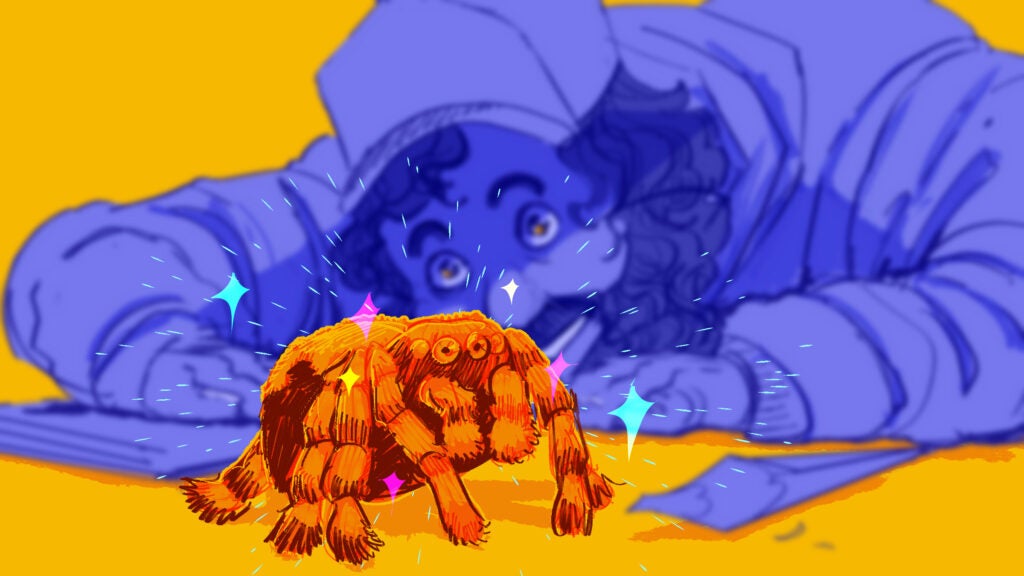No products in the cart.
Outdoor Adventure
Keep Your Bird-Watching—I’m a Spider Man
Let’s get this out of the way: spiders are not as dangerous as you think. Of those 50,449 species in the world, only about 100 are known to be potentially deadly to humans. It’s possible to rule out entire families of spiders as hazardous just by looking at them. No spider anywhere that makes an orb-shaped web—the classic circular pattern from your Halloween decorations—can cause permanent harm to a human. Nor can the googly-eyed, short-legged jumping spiders. Tarantulas aren’t capable of killing you, though the bites of some of the old-world species can be painful. Huntsman spiders grow big enough to kill small bats, but not people.
Even the species that are potentially dangerous to humans—what scientists call the “medically significant” spiders—aren’t nearly as deadly as their reputations would suggest. In the United States, we have two genera that fall into this category: Latrodectus, a group of cobweb spiders that include the three American species of black widow, and Loxosceles, the recluses. They’re both common—I’ve seen friends post pictures of potted plants on Facebook without seeming to be aware of the black widows hanging from them, and in houses where recluses have become established, glue traps can catch the wandering males by the dozens.
But bites from either are rare, and deaths almost unknown. Over the past decade, the American Association of Poison Control Centers has recorded zero fatalities from black widow bites and only one from a recluse. While some recluse bites can cause necrosis, most of the photos you find online of enormous, festering wounds are mislabeled pictures of bacterial infections. If spiders were half as aggressive or dangerous as most people think, the death toll would be apocalyptic, and everyone in Missouri and its surrounding states—the prime habitat of recluses—would be missing at least one limb.
What about Australia, the country where everything can famously kill you? Similar story. Bites from its funnel-web spiders can be deadly, but thanks to modern antivenoms, no one has died from one since 1979; the only recorded spider-related death over the past 43 years in that country took place in 2016, when a hiker passed away from an infection after getting bitten by a redback, Australia’s version of a black widow.
You protest: spiders may not be dangerous, but their bites still hurt, and I get bitten by them all the time. I have news for you. Unless you’ve caught a spider in the act, you probably haven’t been bitten by one. People, including many doctors, are consistently bad at identifying spider bites after the fact. A 2005 article in the New England Journal of Medicine noted that physicians frequently misdiagnose a wide variety of ailments as brown recluse bites, including staph infections, syphilis, skin cancer, and anthrax poisoning. Unlike horseflies or ticks, spiders don’t get any benefit from biting people. Instead, they strike out defensively, usually when they’re in danger of being crushed. If you wake up with a bite, you’d be better off checking your window screens for mosquito-size holes or your mattress for bedbugs.
Spiders aren’t the alien little automatons we often imagine they are: they’re animals, like birds or bunnies or squirrels.
If spiders aren’t dangerous, then, why do we have such an outsize fear of them? One theory is that it’s an evolutionary holdover—an inheritance from our primate ancestors, who didn’t have the ability to distinguish dangerous spiders from innocuous ones, or to treat their bites. In a 2017 study, researchers from Germany’s Max Planck Institute for Human Cognitive and Brain Science and Sweden’s Uppsala University found that six-month-old infants’ pupils dilated—a sign of stress—when shown pictures of spiders but not when shown pictures of flowers. Even bug scientists aren’t immune. A 2013 poll in American Entomologist found that roughly 17 percent of the researchers who responded were arachnophobic.
Other studies, however, have argued that while we evolved to notice spiders, we’re not born afraid of them. A 2011 paper by a trio of researchers from Carnegie Mellon, Rutgers, and the University of Virginia noted that even though a group of three-year-old children could recognize pictures of spiders more readily than other objects, they didn’t necessarily show fear in their presence. Instead, the researchers suggested, arachnophobia is something that adult caregivers pass down to young children by example.
Of course, as Crompton notes, maybe it’s better for the spiders if we’re a bit wary. “There was… a certain young French lady who caught and ate every spider she saw. She found them so delicious she could never resist them,” he writes. “Another such epicure was the once-famous Maria Schurrman who also gobbled up every spider she laid her hands on. She said they tasted of nuts and justified her passion for them by saying she was born under the sign of Scorpio.”
Source link

